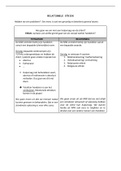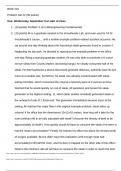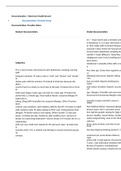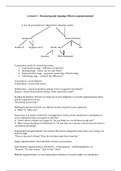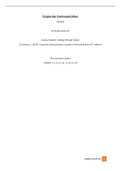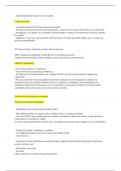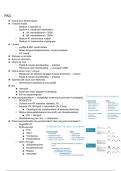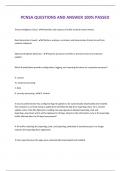GEOLOGICAL MAP
INTERPRETATION
,AGY 205: GEOLOGICAL MAP INTERPRETATION
Course Lecturer: Dr. J. O. Owoseni
Course Content
1. Introduction ..……………………………………………………….........................................................1
2. Maps: Topographic and geologic maps. Elements of topographic maps …..………………………....…2
3. Topographic profile: construction and geological interpretation ………………………………….…… 3
4. Features of geological maps. Geometry of outcrops ……………………………………………….…... 5
5. Methods of determining dip and strike from geological maps: Strike line method ……………………. 4
6. Methods of determining dip and strike from geological maps: From partial outcrops.……….…….….. 5
7. Methods of determining dip and strike from geological maps: From subsurface data. ………………... 7
8. Geological cross-section: mode of construction and interpretation.
Historical reconstruction of geological events from geo-cross-sections…………….………………….12
9. Determination of thickness of rock bed using mathematical and graphical methods ………………… 12
10. Completion of rock outcrop from its partial outcrop on maps using surface
and subsurface data. …………………………………………………………………………………… 23
11. Solving three-point problems using borehole data ……………………………………………………. 32
12. Recognition of different types of folds, faults and unconformities on maps. Igneous intrusions
and their recognitions on maps ……….…………………….…………………………………………. 43
13. Determination of throw of faults from simple geologic maps ………………………..……………….. 27
PRESCRIBED READING
• Butler, B.C.M. and Bell., 1988. Interpretation of geological maps. Longman, UK, 236 pp.
• Fayose, E. A. 1985. Geological map interpretation. Mayton Publishing Consultants, Ibadan, 214 pp.
• Fayose, E. A. Geological map exercises with solutions. AENL Educational Publishers, Ibadan, 140 pp.
• Maltman, A. 1991. An Introduction to geological maps. Open University Press, 208 pp.
AIM OF LEARNING UNIT
The aim of this learning unit is to
• Introduce students to topographic and geological maps, and how to interpret them.
.I
LEARNING OUTCOMES
It is expected that after working through this learning unit, students should be able to
• Construct topographic profile as well as geological cross-sections, and interpret them geologically.
Reconstruct geological history from geological cross-sections.
• Determine the attitude (strike and dip) and thickness of rock beds from geological maps.
• Recognize different geological structures (such as folds, faults and unconformities) and igneous intrusions
on maps.
• Determine throw of faults from geologic maps.
1. INTRODUCTION:
1.1 What is a map?
A map is a 2-dimensional representation of the 3-dimensional configuration of a land surface. It essentially
represents a part of the earth surface as seen when looking down from a great height. Different types of maps
1
,include, topographic maps, geologic maps, economic geological maps, engineering geological maps,
hydrogeological maps, geophysical maps.
2. MAPS:
2.1 Topographic maps
A topographic map shows the diversity of landform by means of contours. It shows the ground or earth features
like the coast lines, rivers, hills, vegetation, cities, highways, dams, bridges, etc. It also shows the relief of the
mapped area by indicating the range of elevation, i.e. height above sea level for several points in the area
Geologist usually use topographic maps as base maps, i.e. field-guide map with which a geologist starts a mapping
work
2.2 Elements of topographic maps
• Orientation: Maps are conventionally oriented in a way that the top is the North, the bottom is the South,
the right is the East and the left is the West
• Latitudes or Parallels: The equator is the line mid-way between the North and the South pole. It
perpendicular to the polar axis. The equator bisects the earth into 2 equal halves. Latitude denotes the
angular distance North or South of this midline. The equator is labelled the zero-degree latitude, and it is
the line of origin from which other latitudes are measured.
• Longitudes or Meridians: The longitude crosses latitude at right angles, and the longitudes merge at the
poles. The prime meridian, or zero meridian, runs through Greenwich in England, and it is the reference
for longitude measurements. It can be measured in any direction, i.e. Eastward or Westward.
• Scale: It gives the relationship between the size of the map and the actual size of the area represented on
the map, i.e. the relationship between the drawn object on paper, which is the map, and the actual physical
object on the ground. The scale can be stated in 3 different ways:
a) Verbal or Statement Scale: a statement scale in the form of an equation, e.g. 1cm = 1km; or 1cm rep.
1km.
b) Fractional or Ratio Scale: is expressed as a fraction or a ratio;
This means that one unit of anything on the map is equal to one million units on the ground. This type of
scale is used for a very accurate map.
c) Graphic or Bar Scale: a bar marked off to show scaled distances in metres, kilometres or any other
units as may be indicated on the map.
1 0 1 2 3 Km
There are usually two parts to a bar scale -
(i) the primary part which is to the right of the zero. This part normally displays the whole numbers;
(ii) the secondary part which is to the left of zero. This usually shows the fractions. A graphic scale is
always included on the map. If a map is to be reduced or enlarged, only the graphic scale remains
correct. Scales are usually put at the top or bottom of maps.
• Direction: This is a straight line on the map or ground measured from a standardized common base line
called the zero direction. The north is regarded as line of zero direction. direction can be expressed in form
of azimuth or bearing.
(i) Azimuths: are directions expressed as angles measured clockwise from the north throughout the
full range of the directional circle. The South is 180o, East is 090o, Southwest is 225o. Three digits
are used in expressing an azimuth.
2
, (ii) Bearings: are measured within each of the 4 quadrants of the directional circle. They are always
measured as angles from the South or North, e.g. azimuth 090 is N90oE, Southeast is S45oE,
South-Southeast is S221/2oE.
Base Line or Base Directions: The North is the generally accepted base direction for both Bearing and Azimuth
measurements. There are 3 types of North directions:
(i) True North: This is the direction to the North pole, represented on the map by the meridians. It is the base
direction used for making most maps.
(ii) Magnetic North: This is the direction established by the needle of the compass. It doesn't coincide with
the true North. The angular difference between the two is called the Magnetic Declination (M.D.). For
practical field mapping, the magnetic compass is used. Therefore, the measurements made are for the
magnetic North as base direction. Corrections have to be made later to obtain readings relative to the true
North. The earth's magnetic field usually causes the magnetic declination. The magnetic north does not
have a stable position.
It shifts gradually every year. Every large-scale or regional map will always give information on the
magnetic declination of the area at the time of making the map. It will also give the predicted annual
change in that area. For example, M.D. annual change of -0.1 implies a movement of magnetic North
towards the true North at a rate of 0.1 degree per year. M.D. annual change of +0.1 implies a movement
of the magnetic North away from the true North (i.e. movement of M.N. eastward) at a rate of 0.1 degree
per year.
(iii) Grid North: This is the direction of the North-South grid lines on a map. It is a North line pointing to the
top of a map.
• Topographic Contour Lines: A contour line connects points of equal altitude above or below the sea
level or ordinance datum (O.D.). The vertical distance between two contour lines is called the contour
interval, and it is the difference in height between any one contour and the next one. The contour lines are
drawn with reference to the datum plane or zero contour. There are two types - form lines and strengthened
contours.
(a) Form Lines: These are the thinner lines and do not have any value printed on them.
(b) Strengthened Contours: These are thicker lines and they bear printed values. They are more carefully
surveyed and more accurately determined. Mm
Strengthened Contour
Generally, the contour lines on a map show the distribution of the high and low grounds. Contour lines also
indicate the variation in the gradient. Close contours indicate steep slope Form
whileline
widely spaced contours show
gentle slope or flat plains.
3

